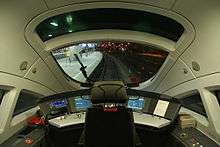Railroad engineer


An engineer (American and Canadian), engine driver, train driver, train operator (British and Commonwealth English), is a person who operates a train. The driver is in charge of, and responsible for driving the engine, as well as the mechanical operation of the train, train speed, and all train handling. The use of the term engineer to describe this occupation in North America should not be confused with the usual meanings of engineer.
For many American railroads, the following career progression is typical: assistant conductor (brakeman), conductor and finally driver. In the US, drivers are required to be certified and re-certified every two to three years.[1] In American English a hostler moves engines around train yards, but does not take them out on the normal tracks.
In India, a driver starts as a diesel assistant or electrical assistant (in case of electric locomotives). They then get promoted on a scale: goods, passenger, Mail/Express and Rajdhani/Shatabdi/Duronto.[2]
In New Zealand, the United States and Canada, train drivers are historically known as "locomotive engineers", or "handelers". In the United Kingdom, South Africa, and Australia they are known as "train drivers", "engine drivers", "locomotive drivers", or "locomotive operators".
Notable railroad engineers
- Ben Chifley, former Prime Minister of Australia[3]
- Casey Jones, American engineer whose wreck on the Illinois Central Railroad on April 30, 1900 was immortalized in verse and music.
The United Kingdom (UK)-based transport historian Christian Wolmar stated in October 2013 that train operators employed by the Rio Tinto Group to transport iron ore across the Australian outback are most likely the highest-paid members of the occupation in the world at that time.[4]
See also
References
- ↑ "2003 CFR Title 49, Volume 4; Part 240: Qualification and Certification of Locomotive Engineers". Code of Federal Regulations. United States National Archives and Records Administration. Retrieved 2007-11-14.
- ↑ "Train Crew". FAQ: Railway Operations. Indian Railways Fan Club. 2007. Retrieved 2007-11-14.
- ↑ Waterson, D.B. "Chifley, Joseph Benedict (Ben) (1885–1951)". Australian Dictionary of Biography. Australian National University. Retrieved 2015-09-06.
- ↑ Elisabeth Behrmann (3 October 2013). "Rio Replacing Train Drivers Paid Like U.S. Surgeons". Bloomberg. Retrieved 3 October 2013.
Further reading
- Huibregtse, Jon R. American Railroad Labor and the Genesis of the New Deal, 1919-1935 (University Press of Florida; 2010; 172 pages)
- Licht, Walter. Working for the Railroad: the organization of work in the nineteenth century (1983)
- Orr, John W. Set Up Running: The Life of a Pennsylvania Railroad Engineman, 1904-1949 (2001)
- Tuck, Joseph Hugh. "Canadian Railways and the International Brotherhoods: Labour Organizations in the Railway Running Trades in Canada, 1865-1914" Dissertation Abstracts International, 1977, Vol. 37 Issue 10, p6681-6681
- White, John H., Jr. "Oh, To Be a Locomotive Engineer," Railroad History, Dec 2003, Issue 189, pp12–33, and Summer 2004, Issue 190, pp 56–76; Examines the role of the railroad engineer 1890 to 1919, discussing qualifications for becoming an engineer and typical experiences on the job.
External links
![]() Media related to Locomotive drivers at Wikimedia Commons
Media related to Locomotive drivers at Wikimedia Commons
- A detailed explanation of what train driving involves, and becoming a train driver in the UK
- Run-A-Locomotive. Link to a site that offers an engineer experience program at a museum in California.
- Train Conductor Job Information
- How to become a train driver guide